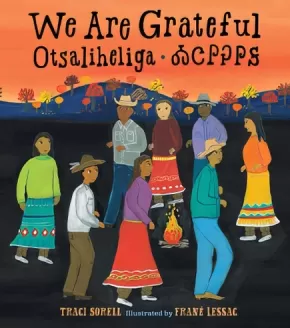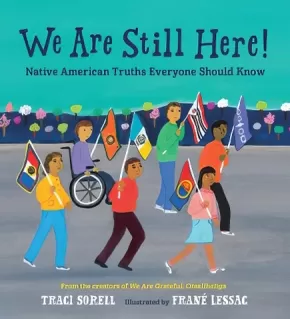Frane Lessac
Frané Lessac is the illustrator of more than forty books for children. She has lived on the small Caribbean island of Montserrat, in London, and in Australia, and her work has taken her on many adventures in numerous countries.
Kids Books (2)
Synopsis:
The Cherokee community is grateful for blessings and challenges that each season brings. This is modern Native American life as told by an enrolled citizen of the Cherokee Nation.
The word otsaliheliga (oh-jah-LEE-hay-lee-gah) is used by members of the Cherokee Nation to express gratitude. Beginning in the fall with the new year and ending in summer, follow a full Cherokee year of celebrations and experiences. Written by a citizen of the Cherokee Nation, this look at one group of Native Americans is appended with a glossary and the complete Cherokee syllabary, originally created by Sequoyah.
Awards
- 2019 Sibert Honor Book
- NPR's Guide to 2018's Great Reads
- Kirkus Reviews Best Books of 2018
- 2018 Book Launch Award (SCBWI)
Reviews
"According to storyteller Sorell, the Cherokee people always express gratitude for the little things they are given by saying the phrase, "Otsaliheliga," or "we are grateful." Raised in the Cherokee Nation, Sorell intentionally crafts a narrative that simultaneously embraces modernity and a traditional presentation of Cherokee community and way of life. Throughout, the measured text reminds readers that in all things "we say otsaliheliga." Colorful, folk art-style illustrations show Cherokee people during ceremonies, in family gatherings large and small, and outdoors enjoying each of the four seasons, always expressing gratitude. The scenes are contemporary; one shows a father taking care of his children, engaging in a positive parenting role, while another depicts a family seeing off a relative who is leaving for deployment in the military, underscoring that Cherokee people serve their country. Children participate in rites and in family outings with adults, and they also play traditional games such as stickball and plant strawberries, a practice that reminds their people to embrace peace with one another. The variety of skin tones represented in the illustrations likewise depicts a present-day reflection of the diversity that exists within the Cherokee people. Occasional Cherokee words are written in Romanized form, phonetically, in Cherokee characters, and in English—a lovely grace note. A gracious, warm, and loving celebration of community and gratitude. —Kirkus Reviews
"An extended family engages with activities and traditions that express gratitude and carry on Cherokee history and culture, such as stomp dancing at the Great New Moon Ceremony, basket weaving, making corn-husk dolls, and playing stickball. The book underscores the importance of traditions and carrying on a Cherokee way of life while simultaneously incorporating modernity and challenging dated media images of Indigenous people. Here, a father sporting an earring and a topknot minds the children; a family bids goodbye to a clan relative who deploys with the U.S. military. Skin colors range from light to dark, visually underscoring the book’s message of diversity and inclusion. Staying firmly upbeat and idyllic, the cheerful, richly detailed gouache illustrations in bright, saturated colors cycle through the seasons, beginning with the Cherokee New Year in autumn. The text includes several Cherokee words; a line of text in a smaller font along the bottom of the page provides each word as written in the English alphabet, its phonetic pronunciation, the word as written in the Cherokee alphabet, and its definition. A glossary, an author’s note on Cherokee culture, and a complete Cherokee syllabary conclude this attractive and informative book." —Horn Book
"In Cherokee culture, Sorell shares, the expression of gratitude is part of daily life and extends from elaborate celebrations to struggles to ordinary life moments. She organizes her debut picture book by seasons, beginning with the fall, which is a time for collecting foliage for basket making and remembering those who suffered on the Trail of Tears. It also contains the Cherokee New Year and the Great New Moon Ceremony, a celebration of renewal and coming together. Each season section starts with the name of the season in Cherokee, an expression of gratitude for the change in nature, and subsequent pages describing community activities pertinent to that season. Lessac's folkloric illustration in bright gouache colors stands in pleasing contrast to the book’s contemporary feel and setting. The text reads like poetry but has a gentle instructional dimension to it. On many pages, Cherokee words are accompanied by English translations, pronunciation guides, and Cherokee syllabary. Back matter contains relevant explanations and provides good context, and the author's note sets past misrepresentations right" —Booklist
"This informative and authentic introduction to a thriving ancestral and ceremonial way of life is perfect for holiday and family sharing"—School Library Journal
Educator Information
Recommended for ages 3 to 7.
Also available in a boxed set as board books for ages 3 and under: We Are Grateful Otsaliheliga: Seasons (BB - Box Set)
Additional Information
| 32 pages | 9.88" x 10.00" |
Synopsis:
Twelve Native American kids present historical and contemporary laws, policies, struggles, and victories in Native life, each with a powerful refrain: We are still here!
Too often, Native American history is treated as a finished chapter instead of relevant and ongoing. This companion book to the award-winning We Are Grateful: Otsaliheliga offers readers everything they never learned in school about Native American people's past, present, and future. Precise, lyrical writing presents topics including: forced assimilation (such as boarding schools), land allotment and Native tribal reorganization, termination (the US government not recognizing tribes as nations), Native urban relocation (from reservations), self-determination (tribal self-empowerment), Native civil rights, the Indian Child Welfare Act (ICWA), religious freedom, economic development (including casino development), Native language revival efforts, cultural persistence, and nationhood.
Reviews
"Students at the Native Nations Community School share presentations about the history, present, and future of Indigenous communities. The vivid artwork features a simple, bold style. The narrative starts with a general introduction of Native Nations in the United States. Each presentation contains illustrations with the student’s name, an overview of the subject, a brief list of the impact that the concept or historical moment had on Native American people, and the refrain “We Are Still Here!” The last pages show students and their families with a variety of skin tones and physical abilities studying the presentations on topics that include sovereign rights and relocation. Additional information, a timeline, a glossary, sources, and an author’s note offer further context. The lyrical text and jewel-tone illustrations elegantly work together to stirringly portray the ongoing fight for Native American recognition and rights. VERDICT An essential purchase for introducing the impact laws and treaties had and continue to have on Native Nations." —School Library Journal, starred review
"In this meticulously researched nonfiction picture book, Sibert honorees Sorell and Lessac team up once again to answer this question: What has happened to Native Nations and their citizens after the treaties with the U.S. government ended in 1871? Lessac’s trademark colorful, folk-art–style illustrations show a Native American community school with a classroom of diverse students preparing for presentations at the Indigenous People’s Day assembly. Spread by spread, each child speaks, featured words and terms highlighting the journey Native Nations have taken to reclaim their land and rights. They show why Indigenous people say, “We are still here!” In the “Assimilation” presentation, Native children are dressed in militarylike uniforms, showing how U.S. leaders used schooling to destroy Native traditions. Dividing plots of tribal land for “Allottment” left much treaty land open for public sale. With “Termination” and “Relocation,” Native people were encouraged to leave their tribal lands and “act more like white people.” But Indigenous people say, “We are still here!” and the narrative arc turns to emphasize resilience. When activists speak up and organize, it strengthens tribal sovereignty. The tribes “protect and provide for future generations” by holding on to their traditional ceremonies, opening businesses to support their tribal members, and reviving their tribal languages. The illustrations, too, change their tenor, modulating from historical wrongs to emphasize contemporary strength, community, and joy. An emphatic, triumphant declaration: “WE ARE STILL HERE!”" —Kirkus Reviews, starred review
Educator Information
Recommended for ages 7 to 10.
This book has a Native American focus.
Additional Information
40 pages | 9.88" x 10.81"







